It is incredibly improbable that a Hawai‘i diver would see a fish species that has never, not even once, been recorded in the Hawaiian Islands. But that is exactly what happened in May when Anthony Kuntz and Julie Gardner visited us from Kauai. The day before coming out on the boat they did a warm-up dive here on Maui. When they got out of the water they had a story to tell, and photos of a fish they had never seen in all of their thousands of dives in Hawaii. Could these Kauai residents have jumped in and seen something that WE hadn’t even seen on our own island?
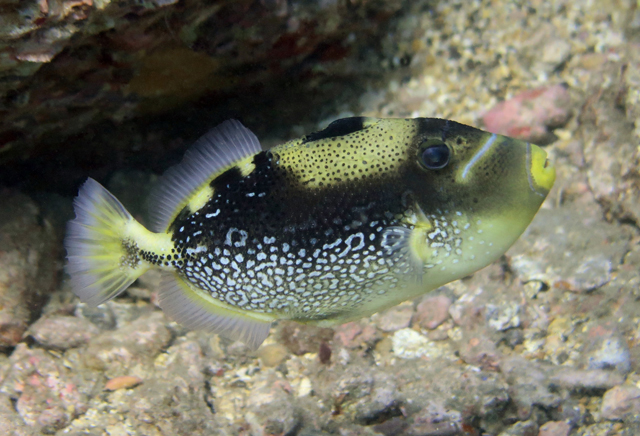
Unusually-patterned Clown triggerfish (Balistoides conspicillum) about 8 inches long, photographed on Maui by Julie Gardner and Anthony Kuntz. May 23, 2017
When they showed us their photos, we agreed that we had never seen this fish in Hawaii either! (Unbeknownst to us, Kelly Hollar at Maui Dreams Dive Company had seen this fish a week earlier. On May 15 while leading a dive, she may have been the first person to ever see – and video – this species of fish in Hawai‘i).
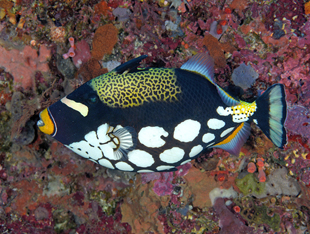
Typical color pattern of an adult Clown triggerfish (Balistoides conspicillum). Indonesia. Photo by Frank Schneidewind.
What Species of Fish is This?
At first we weren’t even sure what species of fish it was. What initially came to mind was a Clown triggerfish (Balistoides conspicillum). But, this isn’t a species that is found in Hawai‘i; it has an Indo-Pacific distribution that does not include Hawai‘i. And, our Maui fish certainly wasn’t an exact match to an adult Clown triggerfish. Perhaps it was a juvenile Clown triggerfish or one transitioning from juvenile to adult? Looking at photos online of juvenile or transitioning Clown triggerfish, it wasn’t an exact match for those either. Even juveniles and young adults have the big white spots on the belly. So what could it be?
I asked Frank Schneidewind, a passionate fish expert and a joy to dive with. He is the author of Drückerfische, the authoritative book on the world’s triggerfishes (in German). Frank confirmed that it is, indeed, a Clown triggerfish. He also re-stated that there is no resident, reproducing population of Clown triggerfish in the Hawaiian Islands. Therefore, this individual is only here for one of two reasons. 1) Someone released him into the ocean here on Maui when he outgrew a home aquarium or 2) He arrived here naturally as a stray larval fish from elsewhere in the Pacific where breeding populations exist.
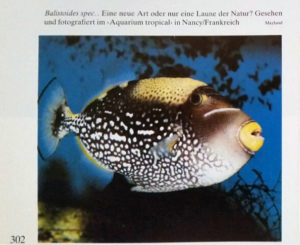
A Clown triggerfish with unusual color pattern in an aquarium. Photo by Hans Mayland in the book Korallenfische by Hans J. Mayland.
As for the Maui fish’s unusual color pattern, Frank reports that he has seen Clown triggerfish in the aquarium trade with this same unusual color pattern. Whether due to the great stress or unnatural diet in captivity, fish species sometimes develop strange color patterns when kept within the four glass walls of a tank. The fish pictured to the right was photographed in the Muséum-aquarium de Nancy in France.
Frank says that unusual coloration can also develop in individuals who naturally arrive as strays outside their normal range of distribution. As in the aquarium release scenario, this abnormal coloration could be due to stress – in this case of living outside their normal geographical range. It could also be the result of eating an unconventional diet in a strange habitat.
Neither Frank nor Dr. Richard Pyle, Ichthyologist at the Bishop Museum in Honolulu, believes this is a hybrid.
Aquarium Release or Natural Arrival
On the one hand, an aquarium release is a possible explanation for a couple reasons. Clown triggerfish are highly prized for their striking appearance, so they are commonly taken from the wild and sold in the aquarium industry. And two, they do not play well with others in an unnatural aquarium situation. Aquarium keepers sometimes release such fish into the wild as they grow and become more aggravated with their tank mates in such a confined space.
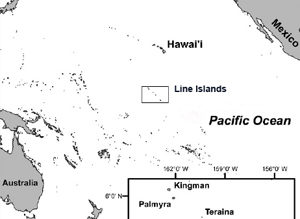
The normal range of the Clown triggerfish extends to the Line Islands, 900 miles south of Hawai‘i.
On the other hand Jack Randall’s “Fishes of the Great Barrier Reef” gives the range of the Clown triggerfish as East Africa to Samoa and the Line Islands. The Line Islands are about 900 miles south of Hawai‘i – close enough for the natural arrival scenario to be an option.
And stray fish do arrive from time to time in Hawai‘i naturally as larvae that have drifted here from places where there are breeding populations. At least 26 such species appear in the literature. One colorful example is the Lined Surgeonfish (Acanthurus lineatus). It is known from only two sightings – one at Hanauma Bay and one at South Point. Another is the Emperor Angelfish (Pomacanthus imperator) known from only three sightings. A third is the Lemonpeel Angelfish (Centropyge flavissima), one individual of which was found in 1928, before the aquarium trade was established. And then there is the Longfin Batfish that re-appears at the St. Anthony wreck every now and then.
Frank believes the most likely scenario is the latter – that it is a stray with mutant coloration that arrived here naturally.
Reef Sweet Reef

Back to our newest exotic arrival, I was able to spend some time observing him in his ex-pat home near the end of July. In the two months since he had first been seen and photographed, his color pattern had become more pigmented and complex. Notice the increased black pigment on the tail and the fine white line around the orange lips. You can see that the pattern on his side has stayed mostly the same, making it easy for us to identify him as the same individual.
Most importantly, he seemed to have found a territory that was working for him. He swam calmly around looking for food. When he strayed from his apparent territory, he was chased off by a Pinktail triggerfish and, later on, by a Picasso triggerfish. He continued on unfazed. None of the other fish seemed to pay attention to him, only those two triggerfish.
He also appeared well-fed. During the twenty minutes that I watched him, he ate several times from the bottom. I even got to watch him eat a brittle star.
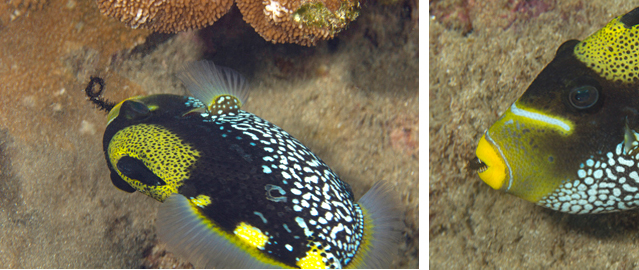
Clown triggerfish eating a brittle star (Ophiocoma erinaceus), Maui, Hawai‘i, July 23, 2017. P. Fiene.
It will be gratifying to watch this fish mature some more, and see him continue to thrive here. If he arrived here naturally, then he has made a long larval journey and deserves a restful home. If he is an aquarium release, then he has endured the fear of being captured as a juvenile in his native home and shipped thousands of miles (Clown triggerfish are not bred in captivity for the aquarium trade). In that case, he now has the opportunity for a vastly more enriched and fulfilling life. In the wild now he can take pleasure in the myriad sights and sounds of the reef. He can enjoy the feel of the surge, interacting with his neighbors, and being stroked by cleaner wrasses. Perhaps most stimulating of all, he can hunt for his own food – including crunchy brittle stars :-).
***Update***
This individual was sighted continuously throughout 2017 including on December 27, 2017 by Kelly Bryce, a snorkel guide with RedLine Rafting. It was sighted by numerous people throughout 2018, and by us as recently as Oct., 2018. He has definitely grown since he was first sighted a year and a half ago.
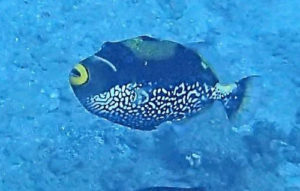
Taken off Pu’u ola’i, Maui. Nov. 1, 2018. Photo courtesy of Maui Dreams Dive Company.
***Big Update***
The clown triggerfish is on the move. After spending the first year and a half in the same location, he traveled. He was sighted off of Pu‘u ola‘i, 1.2 miles south of his original home on Nov. 1, 2018. Thanks to Don Domingo for making sure someone got a photo. If it weren’t for the distinctive pattern on the sides of his body we would never be able to follow him like this.
**This was the last known sighting**
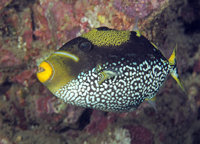 Written by Pauline Fiene. Photos as credited.
Written by Pauline Fiene. Photos as credited.
Thanks to Anthony Kuntz and Julie Gardner of Kauai for telling us about this fish and for sharing their photos; to author Frank Schneidewind for his expert information and photos; to John Hoover for sharing his always-helpful knowledge and sources; to Dr. Richard Pyle for weighing in, and especially to Rob Nelson for showing me this beautiful creature in the wild.

Comments 17
What?? You didn’t show him to me & Geri??? That’s OK. You & crew found a lot of other stuff. Again, we had a great time. Good to see you & crew again (esp. the new guy)
We just saw what appears to be one of these today on Maui. Our photo isn’t nearly as good but it looks pretty close to yours and not at all like any of the standard triggerfish.
I just saw one similar in South Maui. I was shocked. I was not quick enough with the camera. I will be back. I was so shocked because I had just seen something like it on the Internet and then saw it in the water. Thanks for the info everyone. I will be on the lookout.
Author
Thank you for sending the photo David. It is definitely the same individual. If you compare the spot pattern on the side of your fish with the one that we have been seeing you can see they are identical. Pretty cool!
This individual is still here – was spotted today (3/3/18) by friends of mine. I first spotted it last year – still in the same area today.
I think we spotted this individual today. I have pictures and compared the side spots to your pictures in the article.
Would you like me to send you pictures?
Author
Yes, please do. Thanks Carol!
We spotted this fish or one of its brethern yesterday (Mar. 2, 2018) in south Maui.
It was most recently spotted May 13 and 14th. Seems to have moved from my previous sightings.
Author
Thank you for the update. Love hearing that he/she is still there! I’ve updated the article. Mahalo Curtis.
Seen this morning in South Maui…identifiable thanks (many thanks!) to your posted photos…markings (sorry I’m unable to attach my photo on this device) on left side seem to indicate the same individual…
Just saw this clown triggerfish this morning! So cool!
Greatly appreciate the update. Good to know still alive and well. We saw and photographed June 6, 2017. We usually dive S Maui 30 or so times a year and we have not seen the Clown this year. thanks.
Saw one snorkeling off south Maui yesterday near Wailea-Makena. Is that the area it was seen before
?
Author
Yes! Thank you for the recent report.
Hi,
I have entered the report in FishBase with this page as the source (made a pdf of it) Ref. 127448. This will be public only on November.
Could we get the pictures of the individual? Full credits to photographers are assigned and displayed with each picture. FishBase do not get the copyrights on the pictures. Users are asked to contact the photographers. A link back to this page or a page of your preference will be added.
Best regards.
Nicolas Bailly
Q-quatics
FishBase
Author
Hi Nicolas ~
Just emailed our the photos.
~ Pauline